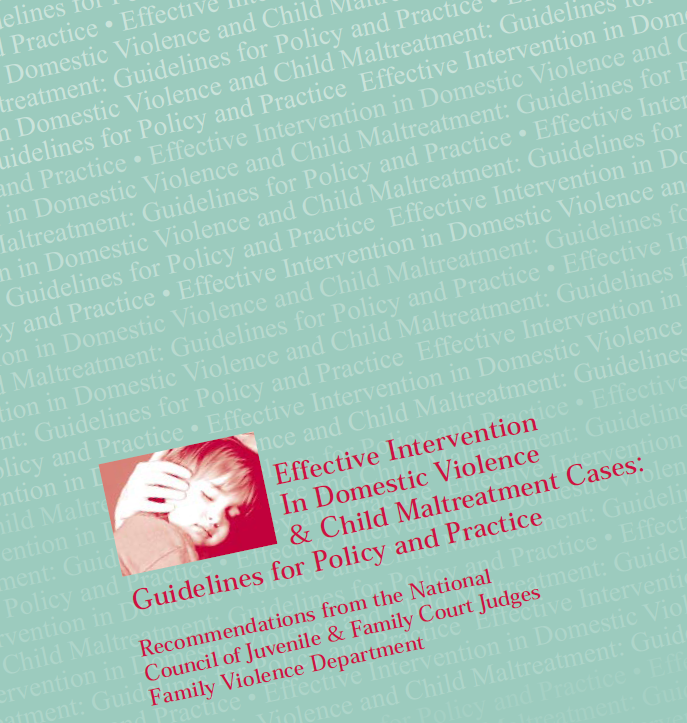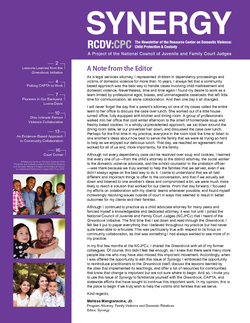Meeting at the Intersections: The Birth of a Collaborative Cohort
Rebekah Tucci, JD, Program Manager, National Council of Juvenile and Family Court Judges
“Why don’t you just get out?” is the overwhelming mantra domestic violence survivors hear. We, as society and community, ignore the little wrinkles like personal repercussions of shared resources, family pressures, children, shared responsibilities, trauma, and love. We dismiss the added layer of society and community and culture and the public nature of it all. We overlook the multi-dimensional aspects of race, gender, sexual orientation, and religion entirely. Instead, we assume that there are functional support systems in place to help survivors who reach out and ask for help. Most of the time, society and the community forget to place the onus on the batterers and puts the focus on the easier targets, the survivors.
With the launch of the Greenbook 20 years ago, the National Council of Juvenile and Family Court Judges (NCJFCJ) and its partners offered a framework and recommendations to guide communities in developing interventions and promoting collaborations at the intersection of domestic violence and child welfare. Twenty years later, the NCJFCJ is still grappling with the same system dysfunction when survivors, specifically survivors with dependent children, seek help.
How does this system dysfunction play out in the lives of survivors, their families, and the communities that attempt to function around them? More often than not, these two systems operate in an uncomfortable cat and mouse stalemate, or worse, they wreak havoc within the family, requiring the survivor to do the heavy lifting or risk losing children and community support. This tension at the intersection is particularly impactful on communities of color, Native American communities, and immigrant communities.1
How do we reimagine community partnerships at this intersection where the kinds of services that families need to flourish are supported and responded to in more holistic, positive ways? How do we break down the barriers in communication and build relationships that increase connectedness and resiliency, honor the values of families and communities, and build hope for future generations?
Those are big questions. Those of us at the Resource Center on Domestic Violence: Child Protection and Custody, the Domestic Violence Resource Network, and countless unnamed organizations and professionals do not have many of the answers. At this intersection, I have witnessed or hosted meetings and conversations that have devolved into finger-pointing and blaming.
Those of us assigned to this task began an inquiry of carefully listening and intentional creation of a safe space where stakeholders and systems players could have honest conversations. One conversation started and “evolved” into many discussions. These conversations included talking with the NCJFCJ’s partners: Futures Without Violence, The National Center on Domestic Violence, Trauma & Mental Health, UJIMA: The National Center on Violence Against Women in the Black Community, and the Division of Family Violence Prevention & Services Family & Youth Services at the U.S. Department of Health & Human Services. These conversations included community leaders, national experts, survivors, and parents affected by child protection services, frontline child welfare workers, and domestic violence advocates. They also included judges, lawyers, and tribal elders. The team thought, wrote, and talked about how to create and sustain a ripple effect and how to support and grow a new way of interacting and reacting at the intersection of domestic violence and child welfare. In all this talking and interviewing and thinking and writing, it was recognized that while each community is dealing with this similar dysfunction and tension, that each community is uniquely situated and dealing with its own very distinctive challenges.
The team repeatedly heard that one of the most effective ways of sustaining those kinds of shifts would be to create a type of cohort — or class where participants at all levels in their professional capacity would be able to come to work on their challenges at this intersection, together.
To provide the best foundation, the team and partners took a multi-layered, multi-dimensional approach to sustain and support the participants. The Meeting at the Intersections cohort would include a cluster of participants from several locations, who would help each other, as well as participants on the state level and at the national level. Participants from Minneapolis, MN, Austin, TX, and Detroit, MI, joined in this effort. The team, partners, and sites will be spending the next two years together in person, virtually, and in community.
The Meeting at the Intersections collaborative cohort represents a hopeful shift in the way the systems do the business of policy and practice and implementation in communities most affected by the systems’ dysfunction.
The team stands at the ready to collaborate with the participants if they need partnership. The group of mentors and teachers stands at the ready to get out of their way if they need space, and to bridge the gap as allies in this work. I do not know how these communities will answer the big questions. I do know that the team is here, ready to support, amplify, and collaborate with them. Stay tuned!
Download Blog as PDF
_______________________
1 Children’s Bureau. Issue Brief November 2016. Racial Disproportionality and Disparity in Child Welfare. https://www.childwelfare.gov/pubpdfs/racial_disproportionality.pdf.
With the launch of the Greenbook 20 years ago, the National Council of Juvenile and Family Court Judges (NCJFCJ) and its partners offered a framework and recommendations to guide communities in developing interventions and promoting collaborations at the intersection of domestic violence and child welfare. Twenty years later, the NCJFCJ is still grappling with the same system dysfunction when survivors, specifically survivors with dependent children, seek help.
How does this system dysfunction play out in the lives of survivors, their families, and the communities that attempt to function around them? More often than not, these two systems operate in an uncomfortable cat and mouse stalemate, or worse, they wreak havoc within the family, requiring the survivor to do the heavy lifting or risk losing children and community support. This tension at the intersection is particularly impactful on communities of color, Native American communities, and immigrant communities.1
How do we reimagine community partnerships at this intersection where the kinds of services that families need to flourish are supported and responded to in more holistic, positive ways? How do we break down the barriers in communication and build relationships that increase connectedness and resiliency, honor the values of families and communities, and build hope for future generations?
Those are big questions. Those of us at the Resource Center on Domestic Violence: Child Protection and Custody, the Domestic Violence Resource Network, and countless unnamed organizations and professionals do not have many of the answers. At this intersection, I have witnessed or hosted meetings and conversations that have devolved into finger-pointing and blaming.
Those of us assigned to this task began an inquiry of carefully listening and intentional creation of a safe space where stakeholders and systems players could have honest conversations. One conversation started and “evolved” into many discussions. These conversations included talking with the NCJFCJ’s partners: Futures Without Violence, The National Center on Domestic Violence, Trauma & Mental Health, UJIMA: The National Center on Violence Against Women in the Black Community, and the Division of Family Violence Prevention & Services Family & Youth Services at the U.S. Department of Health & Human Services. These conversations included community leaders, national experts, survivors, and parents affected by child protection services, frontline child welfare workers, and domestic violence advocates. They also included judges, lawyers, and tribal elders. The team thought, wrote, and talked about how to create and sustain a ripple effect and how to support and grow a new way of interacting and reacting at the intersection of domestic violence and child welfare. In all this talking and interviewing and thinking and writing, it was recognized that while each community is dealing with this similar dysfunction and tension, that each community is uniquely situated and dealing with its own very distinctive challenges.
The team repeatedly heard that one of the most effective ways of sustaining those kinds of shifts would be to create a type of cohort — or class where participants at all levels in their professional capacity would be able to come to work on their challenges at this intersection, together.
To provide the best foundation, the team and partners took a multi-layered, multi-dimensional approach to sustain and support the participants. The Meeting at the Intersections cohort would include a cluster of participants from several locations, who would help each other, as well as participants on the state level and at the national level. Participants from Minneapolis, MN, Austin, TX, and Detroit, MI, joined in this effort. The team, partners, and sites will be spending the next two years together in person, virtually, and in community.
The Meeting at the Intersections collaborative cohort represents a hopeful shift in the way the systems do the business of policy and practice and implementation in communities most affected by the systems’ dysfunction.
The team stands at the ready to collaborate with the participants if they need partnership. The group of mentors and teachers stands at the ready to get out of their way if they need space, and to bridge the gap as allies in this work. I do not know how these communities will answer the big questions. I do know that the team is here, ready to support, amplify, and collaborate with them. Stay tuned!
Download Blog as PDF
_______________________
1 Children’s Bureau. Issue Brief November 2016. Racial Disproportionality and Disparity in Child Welfare. https://www.childwelfare.gov/pubpdfs/racial_disproportionality.pdf.


